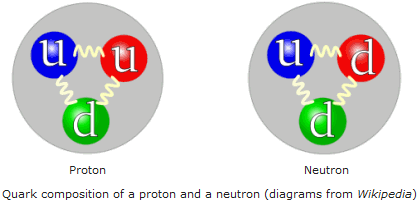My apologies to Austin Powers for the phrasing. But the answer is surprisingly yes, but not in a naive way, given that the Higgs field’s non-zero vacuum value gives mass to all of the fundamental particles.
The complication comes in that the baryonic matter that we live with is made up of protons and bound neutrons, which are each composed of three quarks.
The proton has two up quarks and a down quark, the neutron has two down quarks and an up quark. The up quark has charge +2/3 the magnitude of the electron’s charge, and the down quark has -1/3 of that magnitude. They are bound together by attractive but neutral gluons and held in a bag or linear rising potential made up of stretching gluonic strings, like rubber bands. The proton thus has a charge of that of two up quarks and a down quark: +2/3 +2/3 -1/3 = + 1. The neutron is neutral since its quark charges add up to zero: -1/3 -1/3 +2/3 = 0.
The quarks have an effective mass given by what is called a quark condensate of virtual quark and antiquark pairs in the vacuum. This is about 300 MeV (million electron volts) and three of them make up the mass of the proton and neutron with masses of 938 and 940 MeV, respectively. However, the mass of up and down quarks given without this binding in the starting energy equation by the Higgs vacuum expectation value is about 2.3 MeV for the up quark, and 4.8 MeV for the down quark. The average value of these is about 3.6 MeV.
Now, we are made of Carbon 12, Oxygen 16, extra Hydrogen 1, and some heavier elements in small amounts. The carbon and oxygen have equal numbers of protons and neutrons, so roughly the average quark mass in us is the 3.6 MeV, and for three quarks per nucleon, that gives a Higgs mass contribution per nucleon in us of 10.8 MeV. Out of the 939 MeV average mass of a nucleon in us, the percent weight that we get from the Higgs field’s vacuum expectation value is 10.8/939 = 1.2 %. So for a 200 pound person, this would be 2.4 pounds that we feel when we stand up or sit down. It’s amazing that we have been feeling the Higgs vacuum expectation value all of our lives, but have just almost verified its existence by the likely discovery of the Higgs particle.
A more advanced treatment, as preferred by experts, is that at times the virtual gluon strong force bosons inside the nucleons create a virtual pair of light strange quark and strange anti-quark. This is called the strange quark sea inside the nucleon. They contribute to the total momentum and energy of the nucleon, and can be ejected when the nucleon is struck in a collision. An rough estimate of the percent of time that they are present in the nucleon is about 10%. Since the strange quark and anti-quark have a mass of 150 MeV each, when they are present they make up 300 MeV of the nucleon’s mass. Then 10% of 300 MeV is 30 MeV. With this rough estimate, then 30 MeV / 938 MeV = 3% of our mass comes from the strange quark sea.
Adding the 1% from the up and down valence quarks, and 3% from the strange quark sea, gives 4% of our mass from the Higgs. For the 200 pound person, this gives 8 pounds of mass from the Higgs.

